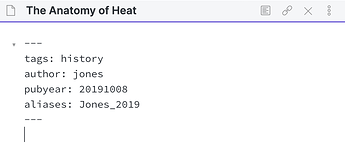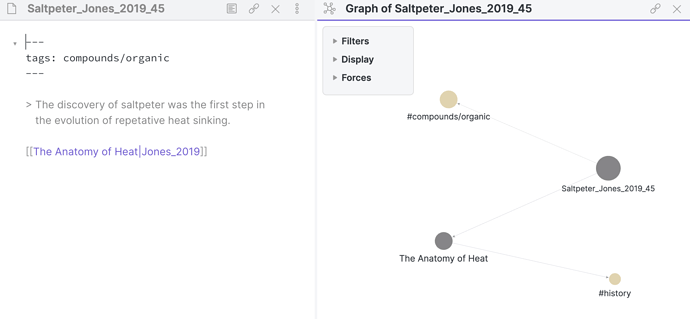A hello from a fellow user,
I am using Obsidian for quite some time and I am struggling a bit with how I take notes. I thought of sharing my use case (yet again) and ask you guys how should I approach it.
So, I am a student having to study a lot of subjects. The problem is with how I take notes from my sources. I wanted to inculcate the habit of Zettlekasten (to be able to use the system even after the exams and continuing the learning process)
- How should I take notes if I am reading from an already structured source?
- What should be the level of atomization for notes?
- Should every point be a new note and linked to the main topic or sub-topic?
- Should I have different level of notes – as in, should I try to take rough notes at one place from, say a chapter, and then convert them into small pieces? Or should I just read the chapter and then go about making notes on a second cursory read from my highlights?
Please share how you take notes from a source that is already very structured for your exam or even for your learning goals.
1 Like
Well - lot’s to unpack there. First let me say that I am no longer studying for exams and when I did there were no digital note-taking tools. On the other hand I have a lifetime of “learning notes” behind me as I have used the technique of learning notebooks to learn material for the past 40 years and have lot’s of notebooks to prove it  . Second let me add that you have to find what works for you - there is no one perfect way for everyone.
. Second let me add that you have to find what works for you - there is no one perfect way for everyone.
With all those caveats - I’d argue that the zettlekasten method may not be the best starting point for learning already structured materials - i.e. for a college course. The zettlekasten method was developed more as a technique to organically grow knowledge toward writing output. In the use case you describe I fear you may be adding a lot of friction to your learning by trying to force it into zk at this stage.
My advice would be to make longer structured notes (by lecture topic or by textbook chapter etc) where you create organized notes in your own words that capture the knowledge in your source material (as you are describing in your #3). Organization is highlighted because the process of organizing the material is important for learning (outlining, “3 types of” etc etc).
I’d suggest you then come back to use those longer structured notes as sources for progressive summarization and/or extract the spaced repetition material you need or capture them into more atomic notes as you see the value in doing that. These later pass-throughs serve as spaced-repetition as well.
To reiterate - what works for you is what matters and everyone’s mileage may vary. But I would argue that zettlekasten as a technique is not necessarily the most efficient way to learn existing structured material. It is a tool oriented toward creating output from knowledge. It adds a fair bit of friction to the process of learning existing materials. That friction can have value later in the process but I would avoid it in my initial note collection.
4 Likes
@greasemonkey’s advice is excellent and sound.
I would add just two bits:
First, when you take a reading note – something about a source article, document, opinion piece, etc., – always add some indication of what this note refers to and when you made the note.
2021-01-01 Finkleman, 2003, pg. 23
Keep a reference card or note somewhere that explains what “Finklemann, 2003” is.
This help avoid the “where did I read that” question we all experience.
The other is, if you own the book – don’t hesitate to mark up the text, add side notes, as much as you want. Not only does this help with retention and understanding – but some day in the future it’s always fun to look at a book and see how your margin notes bring back memories of what you read.
1 Like
@greasemonkey, @anon27868835
Thanks for your replies.
I was caught between the same thoughts. I was taking small bitsized notes, but it was a hassle for me to then organize it again. Since, I was reading from a structured sources (maybe a few sources for same topics, but still more of less structured).
@greasemonkey, your suggestions are really apt for me as of now. I think I will stick to reading while marking (or commenting, as needed) and when I have the understanding of a chapter, I will come back here to create notes in more of a question/answer format (Some of them might end up synced with ANKI for SRS). This goes with what you suggested or I missed some point?
@anon27868835’s suggestion is welcome to me as well. I was trying something like this via zotero, but since I have kept all my books on GoogleDrive or Hard Copy, I feel better if I can just name it here and have a reference card of whatever I read. This would really help.
@anon27868835, should I keep marking the ‘indication’ whenever the content of the note changes pages (location in the book).
- I mean, I I have a topic on say page 23, and next is on page 25. Should I, in practice, include ‘indication’ before starting out note for the secon topic as well?
I agree with marking on the book or pdf as needed. It helps me to take me back to what I was thinking back then. 
Thank you for your suggestions 
My vault is organized with a folder for Reading Notes. I have subfolders of Reading Notes for Reading Notes/Books and so on. In Books I create a note for each book. Each book has an alias for [author]_[pubdate]
Reading notes are atomic: one annotation == one note. The name of the note indicates the major topic of the note and the page number. Here’s an example of a note for the book shown in the first image:
As also shown, this results in a nice graph portraying publication, notes, topic tags, and relationships among them.
This particular note is a quotation, to which in my second review of the notes I can add something of my own reflections on the referenced text.
I don’t usually make the notes in Obsidian while reading, but take written notes then come back to adding them to the vault later.
BTW – the thread is about Zk – and I departed from your original point @DummyME. Apologies for diverging.
1 Like
@EdElgar Thats for an illustrative reply. And no need for an apology, I really liked your way. Although I don’t think it will be easy to keep notes this way if I am having a course material/s.
Also,yyou mmentioned you don’t take notes right away in obsidian, then what is your workflow? From a book to the notes, can you please share? Or maybe we can take it to messages?
Books are 90% analog (paper) and I take marginal notes that I later reread and record to Obsidian.
Digital books become a PDF or EPUB that I import to MarginNote for note taking. I copy the notes from there that I want to keep in Obsidian for further review.
Articles and other PDF sources go into DEVONthink.
Got it.
I mostly use iPad for reading digitally and annotating, while I have a Windows PC. I liked MarginNotes, but sadly its not available for Windows.
I currently follow similar workflow, and now, I think, it will be a lot more streamlined 
Thanks a lot for sharing 
1 Like
 . Second let me add that you have to find what works for you - there is no one perfect way for everyone.
. Second let me add that you have to find what works for you - there is no one perfect way for everyone.

